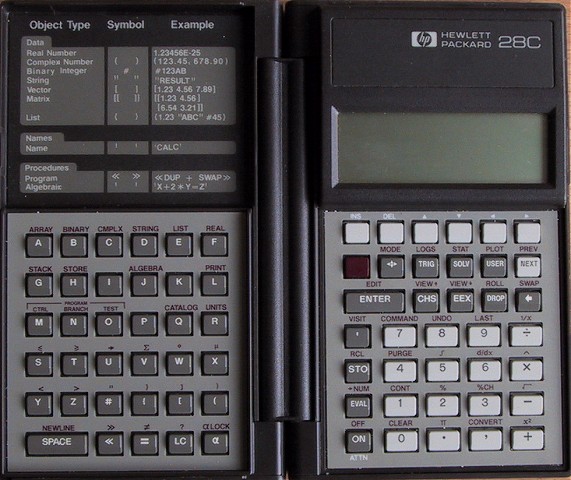hp 28c
in 1986, hp introduced the new rpl system with this model. it was the first hand held device i encountered that even attempted symbolic computation. the new system was object based making available a multitude of data types. the physical construction and style were also totally new. the rather cool book style case opens out so as to lay flat on a desk or fold back on itself so that the unit can be held in one hand with the main set of function keys available. it came with two comprehensive instruction manuals. the getting started manual (which alone is substantial) and the reference manual. |
 |
the screen is 23x4 characters and can accommodate limited graphing. the left keyboard provides character entry, making symbols a bit easier to work with compared to more recent models like the 48g. the supported data types are listed above the alpha keyboard and are:
| real number (floating point) | |
| complex number (float pair) | |
| binary integer (for number bases) | |
| string | |
| vector (array of reals or complex) | |
| matrix (vector of vectors) | |
| list (set of objects) | |
| symbol (names of variables) | |
| procedure (function closure) | |
| formula (symbolic expression) |
it was the first model to make heavy use of soft menus. buttons like trig ot solv display a menu at the base of the display which defines the functions of top row of keys. the solv menu was great. simply put, it would accept a formula and map its unknowns onto the top keys whereupon any one unknown could be solved numerically given the others. this was well done and very useful. new for hp was variable stack length. it was an rpn machine with more than 4 stack levels.
despite the powerful new system, hp had underestimated the memory requirement and to a large extent, the cpu requirement. the 28c has only 2k of ram. it was so small that it was impractical to store programmes in the machine because it needed most of the space itself for internal workspace. the 28c was quickly superseded by the 28s which is the same machine but with 32k of ram.
symbolic features
symbolic quadratic equations are treated specifically, yielding a symbolic answer for both roots. eg 'x^2-6*x+8' 'x quad gives '(6+s1*2)/2' where s1 is the symbolic form of +/-1.
any singly occurring variable can be isolated symbolically. various symbolic manipulations are offered manually, like expand and collect.
symbolic differentiation with respect to a given variable. eg 'tan(x^2+1)' 'x 'd/dx gives '(1+sq(tan(x^2+1)))*(2*x)'.
symbolic integration of polynomials.
symbolic generation of taylor series approximation to an expression. unfortunately very limited in term length due to the small amount of available ram.
other factoids
it was the first to support a wider numerical range. exponents of up to +/-499 can be accommodated.
the real numbers are augmented by +/-maxr, which represents an infinite quantity. the machine can be set to a mode where it uses and returns such quantity rather than generating an error.
mod(1e400,9)=1. good answer.